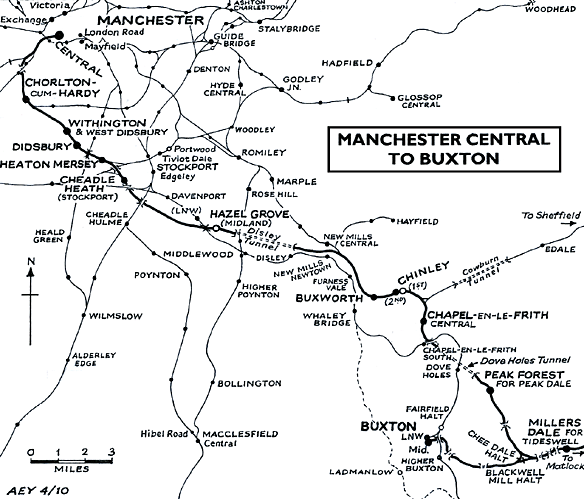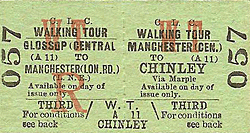
Station Name: CHINLEY (2nd site)
|
| Date opened: | 1.6.1902 | |
| Location: | North side of Station Road. | |
| Company on opening: | Midland Railway | |
| Date closed to passengers: | Still open | |
| Date closed completely: | Still open | |
| Company on closing: | Still open | |
| Present state: |
|
|
| County: | Derbyshire | |
| OS Grid Ref: | SK037826 | |
| Date of visit: | 2.4.2010 |
Notes: Chinley’s 2nd Station opened on the 1st June 1902 and was situated on the Midland Railway’s (MR) main line route from Manchester Central to Ambergate and the associated line to Sheffield which had opened in 1894 and which joined the Ambergate line a mile to the east of Chinley. The line through Chinley had opened in 1867 and the village had been provided with a station which was located a little further to the east than the 1902 station. By the last years of the 19th Century the line through Chinley was carrying so much traffic that congestion was becoming a problem. In addition the MR had gained an act to build a new direct line from New Mills, a few miles west of Chinley, to Heaton Mersey. This new line would speed up main line services thereby making them more competitive against the MRs rivals.
On the 20th September 1900 the MR board agreed a design for the new Chinley Station and a contract was awarded to Messrs Wickenson & Hardy for its construction. Whilst work progressed on the widening of the main line and the building of the new station the original Chinley Station remained open. By May 1902 the station was mostly complete and it opened to passenger services on the 1st June. The original station closed on the same day.
Chinley’s second station was provided with five through platform faces four of which were situated on two island platforms. From north to south the island platform faces were numbered 2, 4, 5 and 6. The other platform face, numbered platform 1, was located on the northernmost platform which had a cutting bank behind it. On the northernmost island platform at its eastern end a bay platform was provided for the use of local services, it was numbered as platform 3.
The southern platform was provided with a single storey timber built building also with canopies. The platforms were all linked together by a covered step bridge that also provided the main way into the station as it continued beyond the platforms to the southern side of the line.
From the day of opening nearly all of the trains passing through Chinley were scheduled to stop at the station. They included main line services to Buxton, Liverpool Central, Manchester Central, Manchester Victoria, Derby, Nottingham Midland, London St Pancras and Sheffield. On some occasions there were 3-way splits with portions from and to Manchester Central, Liverpool Central, and Manchester Victoria (in fact, 4 Down services split 3-ways in the summer of 1904). Some of the Manchester Victoria services also conveyed through carriages from and to Blackburn. Again, in 1904 there were 5 southbound trains with through carriages from Blackburn via Manchester Victoria, while one also conveyed through carriages from Blackpool.
On the 5th January 1904 there was an accident at Chinley Station at 17:38 when the 17:15 service from Buxton crashed into the rear of a stationary mineral train. Thankfully there were no fatalities. The enquiry that followed was critical of the signalling arrangements and so the MR made alterations in 1905. By the early 1920s Chinley Station was being served by 33 trains travelling in the Manchester direction and 35 heading either south towards Derby and beyond or east towards Sheffield. In 1922 67,000 passengers bought tickets at Chinley.
After the war traffic levels were slow to build back and would never reach levels that they had reached during the 1930s. In January 1948 Chinley Station became part of the nationalised British Railways (London Midland Region). Chinley became increasingly attractive as a place to live for Manchester based businessmen who could easily commute by train. Because of this extra commuter services were run. Competition from road transport began to take effect but even in 1965 passenger ticket sales were 25,468. By this time less express services were calling at Chinley but there were still four trains per weekday to London and five from the capital. In 1967 Chinley was served by 26 services running towards Manchester and 25 in the other direction.
The year 1967 was to be quite significant for Chinley as on the 6th of March of that year passenger services that served the stations between Chinley, Buxton and Matlock were withdrawn and all of the intermediate stations closed. London St. Pancras services were diverted from Manchester Central to Manchester Piccadilly on 1st January 1968. London express services were diverted from the Ambergate route on 1st July 1968 via the 1894 Hope Valley line and the south curve at Dore and at a later date routed into Sheffield. Manchester to London St Pancras services had ceased altogether by the end of the 1970s.
In the early 1980s the four track section of line through Chinley Station was reduced to two lines. Only the former platforms 2 and 4 on the northernmost island platform remained in use. On the 9th March 1986, eighty two years after the first crash, the 17:30 Sheffield to Manchester express collided head on with two light engines at almost the same spot as the 1904 crash. Sadly the driver of the express was killed and thirty one passengers were injured, two of them seriously. There was also a crash at Chinley in 1958, the full report can be seen here.
Through Limestone Hills by Bill Hudson. Published by OPC 1989 ISBN 978-0860932178 North West Rails Today by David Clough Published 1986 by Littlehampton Book Services ISBN-13: 978-0711016200 Railways across the Pennines by Stanley Jenkins and Howard Quayle. Published 1990 by Littlehampton Book Services ISBN-13: 978-0711018402 Other web sites: Peak Rail now providing a regular steam service between Matlock and Rowsley. David Hey's Collection - Transition from BR steam. Includes railway photographer ER Morten's photographic tour from Buxton - Derby. Eight and a half miles of the Matlock - Buxton line now forms the Monsal Trail starting at Coombs Road Viaduct, one mile southeast of Bakewell and finishing at the head of Chee Dale, about three miles east of Buxton. There is a diversion round the tunnels. Further reading: Railway from Buxton to Bakewell, Matlock and Ambergate (Scenes from the Past) by JM Bentley, 1992. Railways around Buxton by JM Bentley, 1987. Tickets Michael Stewart except 6616 & 7258 Glynn Waite, route map drawn by Alan Young. Additional source Glynn Waite. To see other stations between Manchester Central & Matlock click on the station name:Manchester Central, Chorlton-cum-Hardy, Withington & West Didsbury, Didsbury, Heaton Mersey, Cheadle Heath, Hazel Grove (Midland), Buxworth,Chinley (1st site), Chapel-en-le-Frith Central, Peak Forest, Cheedale Halt, Buxton (Midland), Blackwell Mill Halt, Millers Dale, Monsal Dale, Great Longstone, Hassop, Bakewell, Rowsley (Second site), Rowsley (First site), Rowsley South PEAK RAIL, Darley Dale, Matlock Riverside PEAK RAIL & Matlock STILL OPEN. See also Stockport Tiviot Dale & Stockport Portwood |
old1.jpg)
Copyright photo from John Alsop collection


old2.jpg)
Copyright photo from John Alsop collection
old7.jpg)
Photo from John Mann collection
old15.jpg)
Photo from B R Sulzer Type 2 web site
old12.jpg)
Copyright photo by H C Casserley

Photo by Alastair Wood. For more of Alastair's railway photos see his flickr photostream
7.jpg)
bay platform had lost its track.
Photo by Alan Young
4.jpg)
Photo by Martin Potter
1.jpg)
Photo by David Dunford, reproduced from Wikipedia under Creative Commons Licence.
14.jpg)
Looking west along the only surviving platform at Chinley's 2nd station in April 2010. This once large interchange station has been reduced to a simple unstaffed halt. There had been another island platform to the left of the picture in the area that is now occupied by housing.
Photo by Paul Wright
| Last updated: Wednesday, 17-May-2017 09:10:16 CEST |
© 1998-2010 Disused Stations
|










 Home Page
Home Page